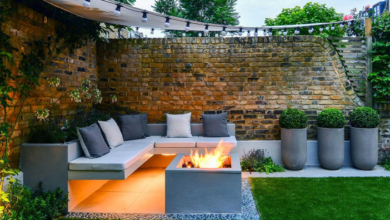How to Design a Wildlife Pond That Supports Nature

Creating a pond in your garden is more than a beautiful landscaping choice—it’s a chance to foster a thriving habitat for birds, amphibians, and beneficial insects. With a few thoughtful decisions, your garden can become a vibrant ecosystem teeming with life.
One of the most overlooked yet crucial tools in maintaining a healthy wildlife pond is a swimming pond vacuum. This eco-friendly solution helps keep your pond clean without harming the very creatures you aim to support.
Let’s dive into the essentials of building and maintaining a wildlife-friendly pond that welcomes nature while staying easy to manage.
Picking the Ideal Spot for Wildlife Success
The first step in building your wildlife haven is choosing the right location. Aim for a balance of sun and shade throughout the day. Too much sunlight can cause algae blooms, while excessive shade may limit plant growth, reducing shelter and oxygen levels in the water.
Locate your pond near shrubs or natural hedges to offer privacy and a safety buffer for animals. The location should also be free from chemical runoff from lawns or nearby structures.
Go Native with Aquatic Plants
Native aquatic plants are the foundation of a self-sustaining wildlife pond. These species are adapted to your local climate and provide crucial benefits:
- Water lilies help control sunlight and prevent overheating.
- Cattails and rushes offer shelter and nesting sites.
- Floating plants like duckweed support tiny organisms that serve as food for larger species.
Position marginal plants around the edge to support frogs, bees, and other garden visitors. Plants also work as natural filters, improving water clarity and stability—especially when combined with regular use of a swimming pond vacuum.
Design for Safe Entry and Exit
A wildlife pond should feature gradual slopes and a variety of depths. Shallow areas around the perimeter allow easy access for birds and mammals to drink and bathe. Amphibians, such as frogs and salamanders, use these zones to spawn and hide from predators.
Avoid steep vertical edges that could trap small animals. Gentle inclines also make it easier for beneficial insects like dragonflies to emerge from the water as they mature.
Add Natural Structures to Attract Visitors
Natural features bring both beauty and ecological function to your pond. Here are a few ideas:
- Rocks and boulders offer sunbathing spots for turtles and perches for birds.
- Logs and branches create hidden shelters for frogs, toads, and newts.
- Gravel or pebble bases allow beneficial bacteria to grow and help filter the water.
Each of these features enhances biodiversity and makes your pond a haven for all kinds of wildlife.
Avoid Harsh Chemicals—Go Natural Instead
Chemical fertilizers, herbicides, or pesticides can disrupt the delicate pond ecosystem. They may eliminate insects and pollinators or even poison amphibians.
Instead, control algae and maintain clarity by using natural strategies:
- Introduce beneficial bacteria that break down organic waste.
- Skim out debris regularly.
- Use a swimming pond vacuum to remove built-up sludge and muck from the bottom of the pond without harming the water balance or beneficial microbes.
These eco-friendly practices help maintain optimal water quality and preserve the health of your pond residents.
Invite Insects That Help Your Garden Thrive
Insects like dragonflies and damselflies aren’t just beautiful—they’re your pond’s pest control team. Dragonfly larvae consume mosquito larvae, reducing the need for chemical treatments.
To attract beneficial insects:
- Avoid using chemical pesticides near your pond.
- Plant species like iris and sedge that provide cover and egg-laying surfaces.
- Keep the water surface partially open and clean using your swimming pond vacuum, giving insects room to land and hunt.
Healthy insect populations also attract birds, frogs, and bats, completing the natural cycle.
Set a Routine for Eco-Safe Pond Maintenance
Routine maintenance is critical for the longevity of a wildlife pond. Here are key tasks to perform throughout the year:
- Remove fallen leaves and debris, especially during autumn.
- Trim and divide aquatic plants to prevent overcrowding.
- Test water pH and nitrate levels to monitor pond health.
- Use a swimming pond vacuum seasonally to keep sludge buildup under control.
Avoid drastic changes in water levels or chemistry, especially during breeding seasons. Even well-intentioned disruptions can be harmful to eggs and juvenile wildlife.
Use Eco-Friendly Tools for Cleaner Water
A swimming pond vacuum is one of the most effective tools for keeping your wildlife pond clean without disrupting its ecosystem. Unlike standard pool vacuums or harsh cleaning chemicals, swimming pond vacuums are designed to gently remove debris, sludge, and algae.
Benefits include:
- Cleaner water without draining the pond
- Safe operation around fish, frogs, and insects
- Better filtration and oxygen levels for plants and animals
Look for a vacuum with adjustable suction and sediment collection features, allowing you to clean precisely where needed.
Enjoy a Wildlife Pond Year-Round
As the seasons change, your pond will become a dynamic part of your garden. Birds may visit to bathe in spring, frogs may lay eggs in summer, and dragonflies will patrol in the fall.
With regular upkeep and a focus on biodiversity, you’ll enjoy a living water feature that enhances your entire yard—not just aesthetically but ecologically.
Clearing Up Confusion
How often should I use a swimming pond vacuum?
Use it once every few weeks during the warmer months or after major weather events. If you notice a layer of sludge at the bottom, it’s time for a vacuum session.
Will a swimming pond vacuum harm fish or frogs?
No. Swimming pond vacuums are designed to be gentle. Always choose one with adjustable suction and avoid cleaning during breeding seasons for amphibians.
Can I build a wildlife pond without fish?
Absolutely. In fact, some experts recommend skipping fish if your primary goal is to support frogs, insects, and other native wildlife that may be disturbed by fish predation.
What plants should I avoid in a wildlife pond?
Avoid invasive species like water hyacinth or yellow flag iris. These can outcompete native plants and harm the balance of your pond ecosystem.
Is a filter necessary if I use a swimming pond vacuum?
Yes. A filtration system complements vacuuming by maintaining water quality between cleanings. Use both for optimal results.
Final Thoughts
A wildlife pond offers more than beauty—it supports pollinators, reduces pests, and creates a peaceful retreat for you and nature. With thoughtful design, native plants, and routine care using a swimming pond vacuum, your pond will flourish across the seasons.
Start small or go big—either way, your garden will be richer for it, and so will the wildlife that calls it home.



